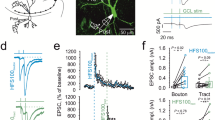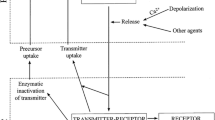Abstract
The release of endogenous amino acids from depolarized rat hippocampal mossy fiber synaptosomes was investigated to assess the possible role(s) of glutamate and aspartate in mediating the excitatory mossy fiber synaptic input. The relative proportions of prodynorphin-derived peptides concomitantly released with amino acids were also determined to further characterize the biochemical basis for mossy fiber synaptic transmission. Of the 18 amino acids shown to be present in superfusate fractions by liquid chromatographic analysis, only glutamate was released at a significantly enhanced rate from K+-stimulated (35 mM KCl) mossy fiber nerve endings. The rates of glutamate and aspartate release were increased by 360±27% and 54±12% over baseline respectively. However, the K+-evoked release of glutamate was substantially more Ca2+-dependent (80%) than was the release of aspartate (49%). The veratridine (45 μM)-evoked release of both acidic amino acids was entirely blocked by 1 μM tetrodotoxin. Depolarization (45 mM KCl) also stimulated the release of the four prodynorphin (Dyn) products examined, in a rank order of Dyn B >> Dyn A(1–17) > Dyn A(1–8) >> Dyn A(1–13), with Dyn B efflux increasing by more than 5-fold over baseline values. These results suggest that the predominant excitatory amino acid in hippocampal mossy fiber synaptic transmission may be glutamate and that this synaptic input may be modulated by at least four different products of prodynorphin processing.
Similar content being viewed by others
References
Amaral, D. G., and Dent, J. A. 1981. Development of the mossy fibers of the dentate gyrus: 1. A light and electron microscopic study of the mossy fibers and their expansions. J. Comp. Neurol. 195:51–86.
Claiborne, B. J., Amaral, D. G., and Cowan, W. M. 1986. A light and electron microscopic analysis of the mossy fibers of the rat dentate gyrus. J. Comp Neurol. 246:435–458.
Frederickson, C. J., Klitenick, M. A., Manton, W. I., and Kirkpatrick, J. B. 1983. Cytoarchitectonic distribution of zinc in the hippocampus of man and the rat. Brain Res. 273:335–339.
Chavkin, C., Bakhit, C., Weber, E., and Bloom, F. E. 1983. Relative contents and concomitant release of prodynorphin neoendorphin-derived peptides in rat hippocampus. Proc. Natl. Acad. Sci. USA. 80:7669–7673.
McGinty, J. F., Henriksen, S. J., Goldstein, A., Terenius, L., and Bloom, F. E. 1983. Dynorphin is contained within hippocampal mossy fibers: Immunochemical alterations after kainic acid administration and colchicine-induced neurotoxicity. Proc. Natl. Acad. Sci. USA. 80:589–593.
Gustafsson, B., and Wigstrom, H. 1988. Physiological mechanisms underlying long-term potentiation. Trends In Neurosci. 11:156–162.
Barrionuevo, G., Kelso, S. R., Johnston, D., and Brown, T. H. 1986. Conductance mechanism responsible for long-term potentiation in monosynaptic and isolated excitatory synaptic inputs to hippocampus. J. Neurophys. 55:540–550.
Harris, E. W., and Cotman, C. W. 1986. Long-term potentiation of guinea pig mossy fiber responses is not blocked by N-methyl-D-aspartate antagonists. Neurosci. Lett. 70:132–137.
Ito, I., Okada, D., and Sugiyama, H. 1988. Pertussis toxin suppresses long-term potentiation of hippocampal mossy fiber synapses. Neurosci. Lett. 90:181–185.
Terrian, D. M., Johnston, D., Claiborne, B. J., Ansah-Yiadom, R., Strittmatter, W. J., and Rea, M. A. 1988. Glutamate and dynorphin release from a subcellular fraction enriched in hippocampal mossy fiber synaptosomes. Brain Res. Bull. 21:343–351.
de Montigny, C., Weiss, M., and Ouellette, J. 1987. Reduced excitatory effect of kainic acid on rat CA3 hippocampal pyramidal neurons following destruction of the mossy projection with colchicine. Exp. Brain Res. 65:605–613.
Gannon, R. L., Baty, L. T., and Terrian, D. M. 1989. L(+)-2-Amino-4-phosphonobutyrate inhibits the release of both glutamate and dynorphin from guinea pig but not rat hippocampal mossy fiber synaptosomes. Brain Res. 495:151–155.
Lindroth, P., and Mopper, K. 1979. High performance liquid chromatographic determination of subpicomole amounts of amino acids by precolumn fluorescence derivatization witho-phthaldialdehyde. Analytical Chemistry 51:1667–1674.
Levi, G. 1984. Release of putative transmitter amino acids. Pages 463–509,in Lajtha, A. (ed), Handbook of Neurochemistry 6: Receptors in the Nervous System, Plenum Press, New York, NY.
Flint, R. S., Rea, M. A., and McBride, W. J. 1981. In vitro release of endogenous amino acids from granule cell-, stellate cell-and climbing fiber-deficient cerebella. J. Neurochem. 37:1425–1430.
Liu, C. J., Grandes, P., Matute, C., Cu'enod, M. and Streit, P. 1989. Glutamate-like immunoreactivity revealed in rat olfactory bulb, hippocampus and cerebellum by monoclonal antibody and sensitive staining method. Histochem. 90:427–445.
Altschuler, R. A., Monaghan, D. T., Haser, W. G., Wenthold, R. J., Curthoys, N. P., and Cotman, C. W. 1985. Immunocytochemical localization of glutaminase-like and aspartate aminotransferase-like immunoreactivities in the rat and guinea pig hippocampus. Brain Res. 330:225–233.
Yoshida, M., Teramura, M., Sakai, M., Karasawa, N., Nagatsu, T., and Nagatsu, I. 1987. Immunohistochemical visualization of glutamate-and aspartate-containing nerve terminal pools in the rat limbic structures. Brain Res. 410:169–173.
Crawford, I. L., and Connor, J. D. 1973. Localization and release of glutamic acid in relation to the hippocampal mossy fibre pathway. Nature (London). 244:442–443.
Author information
Authors and Affiliations
Additional information
The animals involved in this study were procured, maintained and used in accordance with the Animal Welfare Act and the “Guide for the Care and Use of Laboratory Animals” prepared by the Institute of Laboratory Animal Resources—National Research Council.
Rights and permissions
About this article
Cite this article
Terrian, D.M., Gannon, R.L. & Rea, M.A. Glutamate is the endogenous amino acid selectively released by rat hippocampal mossy fiber synaptosomes concomitantly with prodynorphin-derived peptides. Neurochem Res 15, 1–5 (1990). https://doi.org/10.1007/BF00969176
Accepted:
Issue Date:
DOI: https://doi.org/10.1007/BF00969176




